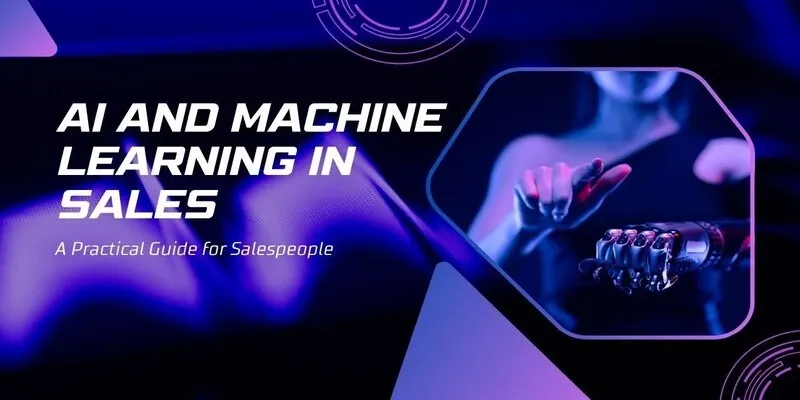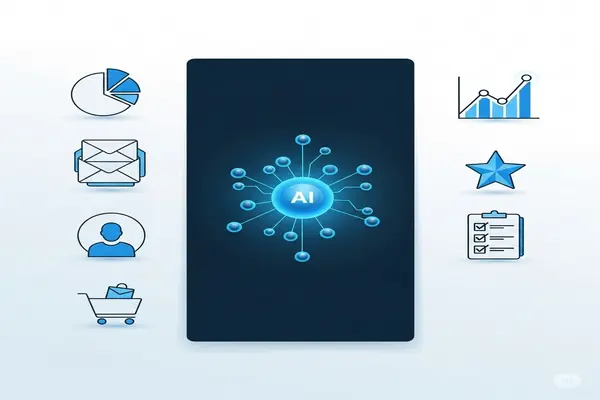AI and Machine Learning in Sales: A Practical Guide for Salespeople
AI and ML transform sales by scoring leads, timing outreach, and personalizing emails to enhance customer engagement. Tools like guided selling and reinforcement learning can boost conversions up to 43%. Start small, avoid bad data, and let AI be your smartest sales assistant without replacing you.

Let’s say you’re trying to close more deals, find the right customers faster, and spend less time stuck in admin work. Artificial intelligence and Machine Learning (ML) can help you do exactly that, not by replacing you, but by becoming your smartest assistant. This is not about gimmicky tech. It’s about using tools that make you better at your job.
In this guide, I’ll walk you through how sales teams, whether solo freelancers or big enterprise reps, are using AI and ML today. And I’ll also show you a few things nobody talks about enough, but can give you an edge.
A Practical Guide for Salespeople
Start with What AI Actually Means in Sales
AI (Artificial Intelligence) in sales doesn’t mean a robot closing deals on your behalf. It’s about teaching machines to spot patterns in customer behavior, make suggestions, and take care of repetitive stuff like emails or lead scoring.
Machine learning is just one part of AI. It basically looks at all your past sales, who bought, when they bought, and what made them say yes, and then uses that to guess what might happen next. It's like having an assistant who never forgets a thing and is always learning on the job.
Lead Scoring Just Got Smarter
If you’re still ranking leads manually or just going with your gut, you’re missing out.
AI can score your leads automatically by analyzing past deals. It looks at things like company size, email engagement, job title, website activity, and more. Then it gives you a clear signal, “this one is hot” or “this one’s just browsing.”
Even better? Some AI tools can tell you why a lead scored high or low. That’s where explainable AI comes in. It helps you actually understand why the system is making certain suggestions, so you’re not just following it blindly. When you know the reason behind it, it’s easier to trust the process. Otherwise, people often ignore good advice just because it came from a machine.
Timing Is Everything and AI Knows When to Strike
Here’s something not many salespeople talk about: AI can help you reach out at the perfect moment.
Let’s say your lead just got promoted or their company raised funding. AI tools can scan news, social media, and even internal databases to catch that, and then notify you it’s time to send that follow-up. These are called real-time sales triggers, and they work.
By aligning your outreach with the customer’s external context, you sound informed and relevant, not random.
Email Personalization That Doesn’t Sound Robotic
AI can write emails, sure, but that’s not the real win.
What you want is dynamic personalization. That means your AI assistant can generate a message that adapts to what the person’s interested in, what stage of the funnel they’re in, and what their industry pain points are.
You’ll still want to tweak it (you’re the human here), but it’s way faster and much more relevant than sending cold, generic emails.
Guided Selling: Your Next Step, Always Clear
Sometimes you’re just not sure what to do next with a prospect. Should you call them? Send a case study? Ask for the close?
AI-powered guided selling tools use historical data to suggest your best move. These recommendations are based on what worked for similar customers in the past. It’s like having your most experienced colleague whisper in your ear, Here’s what usually works right now.
Machine Learning Development: How These Systems Actually Work
Behind the scenes, all of this is powered by Machine Learning Development, the process of building, training, and improving models that learn from sales data.
Here's a quick look at how it happens:
Data Collection: Your CRM, website analytics, and emails are all used as training data.
- Training: Models learn patterns using techniques like regression, decision trees, or even reinforcement learning.
- Testing: These models are tested to make sure they give accurate recommendations.
- Deployment: Once ready, they’re plugged into your sales tools.
- Monitoring: Over time, feedback from your team helps improve accuracy.
The Power of Reinforcement Learning
Here’s where things get really interesting.
Reinforcement Learning is like teaching your AI through experience. Just like a sales rep learns from each deal they close (or lose), these models learn what actions lead to conversions and improve with each attempt.
A new framework called SalesRLAgent, for example, acts like a coach during live calls. It tells reps what to say next, based on live feedback and previous success rates. It’s still early-stage, but this kind of AI will soon be like having a strategist on every call.

Smart Training and Onboarding for Sales Teams
AI isn’t just for customers, it can help train your sales team, too. Generative AI is now being used to simulate buyer objections, complex scenarios, and role-play calls. That means reps can practice over and over with AI-driven coaching until they’re confident to talk to real prospects.
This cuts onboarding time and makes new hires productive faster.
Real Benefits: What You Can Expect
When used well, here’s what AI and ML can bring to your sales efforts:
- Better conversion rates from smarter lead targeting.
- Faster sales cycles thanks to guided selling and automation.
- Higher customer satisfaction due to personalization and timely follow-ups.
- Less admin work, like logging calls or writing emails.
- Smarter forecasts for pipeline and revenue planning.
Even big players like LinkedIn have seen tangible results. Their ML-driven Account Prioritizer delivered an 8% increase in renewal bookings by focusing reps on the right accounts.
What You Need to Watch Out For
Like any powerful tool, AI comes with risks:
- Bad data in = bad results. Your CRM must be clean.
- Bias in models. If your data is biased, your predictions will be too.
- Over-reliance on automation. Let AI assist, not control.
- Lack of transparency. Use tools that explain their reasoning.
Final Thoughts: Don’t Wait, Start Small
You don’t need to overhaul your entire sales system to get started. Pick one area, maybe lead scoring or email outreach, and try one AI tool that fits your workflow. Let the results speak for themselves. AI and Machine Learning are not magic. But when used right, they become the most powerful sales assistant you’ll ever have.
And the best part? You still make the decisions. AI just helps you make smarter ones.


